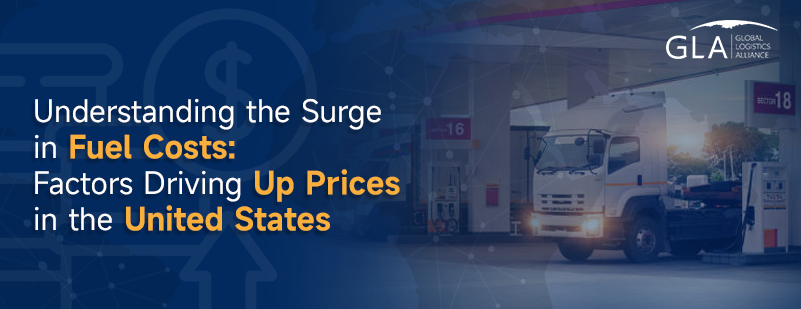Welcome to GLA! Leading the global logistics alliance.


Your location:Home > News > Understanding the Surge in Fuel Costs: Factors Driving Up Prices in the United States
Time:2023-12-08 Publisher:Kevin Num:2012

Americans have been feeling the pinch at the pump as fuel prices continue to climb. While fluctuations in gas prices are nothing new, the recent surge in costs has left many wondering about the reasons behind this unwelcome trend. In this article, we delve into the factors contributing to the escalation of fuel costs in the United States.
Surging Demand and Disrupted Refineries
One of the primary drivers of the skyrocketing fuel prices is the surging demand for gasoline and diesel across the country. As people return to their pre-pandemic routines and travel more extensively, the demand for fuel has reached unprecedented levels. U.S. oil refineries are currently running at maximum capacity in order to meet the rising demand. However, their capacity to restock fuel reserves has been hindered by a notable surge in mechanical failures, resulting in disruptions to fuel production and distribution.
Price Increases in Midwest and West Coast
The first indications of trouble became apparent in the Midwest, as retail gasoline prices surged to an astonishing $4 per gallon in states such as Minnesota.Shortly afterward, the West Coast encountered significant price spikes, causing drivers in Los Angeles and San Diego to contend with gasoline costs reaching as much as $6 per gallon. These price spikes were directly linked to refinery outages in these regions, creating a ripple effect that impacted fuel prices nationwide.
Specific Refinery Shutdowns
The situation has been worsened by the shutdown of particular refineries, such as Valero Energy's McKee refinery in Texas and Phillips 66's Ponca City refinery in Oklahoma. These closures have played a role in the Midwest gasoline markets becoming even more constrained, adding to the challenges of balancing supply and demand.
Rise in Mechanical Problems
Information provided by the energy research company IIR indicates a 53% increase in unforeseen mechanical complications occurring at American refineries in the first three quarters of this year when compared to the corresponding timeframe in the prior year. These mechanical complications encompass various problems, such as compressor failures, steam loss, tube leaks, and other disruptions within the refining process. These malfunctions have resulted in production and distribution delays, worsening the fuel shortage.
Surge in Crude Oil Prices
Another significant factor contributing to the nationwide surge in fuel costs is the global price of crude oil. With crude oil prices exceeding $90 per barrel, the cost of producing gasoline and diesel has risen substantially. This increase in production costs is inevitably passed on to consumers at the pump.
Potential Short-Term Alleviation
While the situation appears grim, some analysts suggest that there may be a glimmer of hope in the form of more affordable winter-grade gasoline. Starting this month, the transition to winter-grade gasoline could offer temporary relief from the high prices that have burdened consumers.
Depleted Inventories
Fuel inventories in the United States have taken a hit due to refinery outages. Gasoline inventories are presently 4% lower than the typical level for this period, while diesel and other distillates are significantly down by 14%. These diminished stockpiles are exacerbating supply chain challenges and contributing to the mounting price pressures.
In summary, the recent increase in fuel prices in the United States is the result of a complex interplay of factors. Heightened demand, refinery disruptions, soaring crude oil prices, and dwindling fuel inventories have all contributed to this challenging situation. As we move forward, it is essential to monitor these factors closely, as they could continue to exert pressure on prices, potentially leading to further hikes later in the year. For now, consumers will need to adapt to these challenging circumstances and explore strategies for managing their fuel expenses in an era of heightened uncertainty at the pump.
Prev:UPS to Hire Over 100,000 Seasonal Workers Amidst Fierce CompetitionNext:Welcome! New Golden Member from USA ———— Rose Containerline
Recommended Membership
Latest News